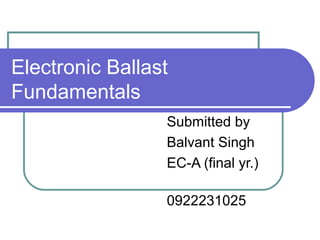
Energy Efficient Electronic Ballast Fundamentals
- 1. Electronic Ballast Fundamentals Submitted by Balvant Singh EC-A (final yr.) 0922231025
- 2. Contents 1. Types of Ballast 2. Basics of Electronic Ballast 3. Starting Methods 4. Fluorescent tube 5. Lamp Structure 6. Working of lamp 7. Startup Circuit 8. Advantages of EB
- 3. Types of Ballast 1. Electromagnetic 2. Hybrid 3. Electronics Purpose of EB a. Provide a start−up voltage, b. Maintain a constant current, c. Assure that the circuit will remain stable.
- 4. Basics of Electronic Ballasts C1 L C2 Halfbridge configuration The resonant circuit strikes on the lamp
- 5. A. Instant start electronic ballasts Start lamps without delay (<0.1 seconds) or flicker by providing a starting voltage that is sufficiently high to start a discharge through the lamps without the need for heating lamp electrodes. , the starting voltage is about 600V. Lamps operated by instant start ballasts typically operate 10,000 to 15,000 switch cycles before failure.
- 6. B. Rapid start electronic ballasts Start lamps quickly (0.5 – 1.0 seconds) without flicker by heating the lamp electrodes and simultaneously applying a starting voltage. Lamps operated by rapid start ballasts typically operate 15,000 to 20,000 switch cycles before failure.
- 7. C. Programmed start electronic ballasts Programmed start ballasts are designed to provide maximum lamp life in frequent lamp starting applications such as in areas where occupancy sensor controls are used. . Lamps operated by programmed start ballasts typically operate up to 50,000 switch cycles before failure.
- 8. Fluorescent tubes Much more efficient than incandescent lamps : 2 to 4 times more efficient. Less energy required to operate. Eco-friendly for environment. The lamps are much cooler than incandescent lamps.
- 9. Lamp Structure The lamp is a sealed tube containing mercury vapor and some inert gases such as argon at very high pressure The inside of the tube is coated with phosphor At the ends of the tube there are filaments or electrodes
- 10. How does it work? When the tube is off it does not conduct It is turned on by a high voltage which excites the gas inside the tube Once the tube conducts on a lower voltage is sufficient to maintain conduction The electric current passes through the gas and emits UV, the internal phosphor coating converters the UV to visible light The color of the light cab be varied by different combinations of phosphors
- 11. Lamp starting When the lamps is off the tube is non -conductive The tube must be excited or started by a high voltage After the lamps is started the lamp voltage drops A current limiting “ballast” is needed in between the power source and the lamp
- 12. Start up circuit
- 13. Starter switch
- 14. Advantages: 1) Dimmable (only applicable for expensive products that are not commercially competitive in public lighting systems); 2) Energy saving; 3) No flickering effect.
